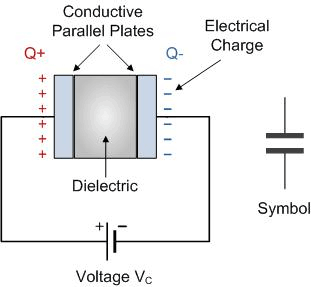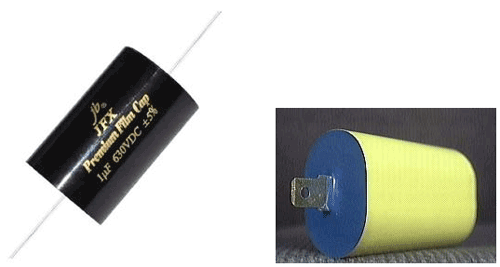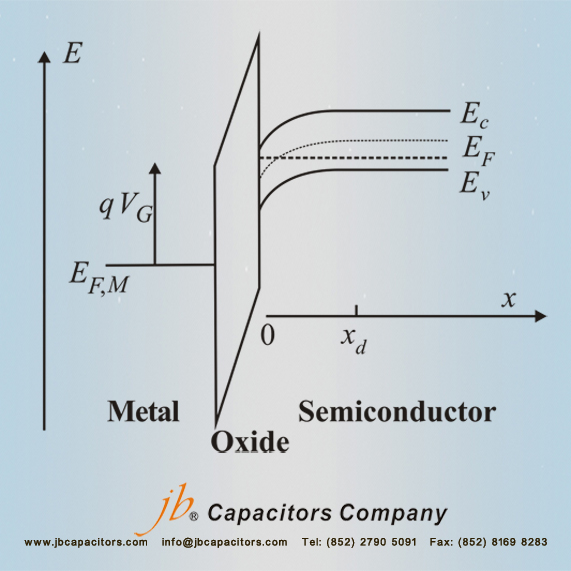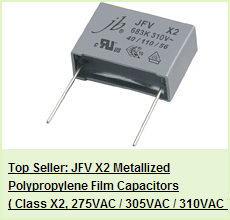2011-2-25 21:10:10
views
The unit of capacitance is the Farad (abbreviated to F) named after the British physicist Michael Faraday and is defined as a capacitor has the capacitance of One Farad when a charge of One Coulomb is stored on the plates by a voltage of One volt. Capacitance, C is always positive and has no negative units. However, the Farad is a very large unit of measurement to use on its own so sub-multiples of the Farad are generally used such as micro-farads, nano-farads and pico-farads, for example.
Microfarad (μF) 1μF = 1/1,000,000 = 0.000001 = 10-6 F
Nanofarad (nF) 1nF = 1/1,000,000,000 = 0.000000001 = 10-9 F
Picofarad (pF) 1pF = 1/1,000,000,000,000 = 0.000000000001 = 10-12 F
The capacitance of a parallel plate capacitor is proportional to the area, A of the plates and inversely proportional to their distance or separation, d (i.e. the dielectric thickness) giving us a value for capacitance of C = k( A/d ) where in a vacuum the value of the constant k is 8.84 x 10-12 F/m or 1/4.π.9 x 109, which is the permittivity of free space. Generally, the conductive plates of a capacitor are separated by air or some kind of insulating material or gel rather than the vacuum of free space.

2011-2-23 7:4:44
views
The parallel plate capacitor is the simplest form of capacitor and its capacitance value is fixed by the surface area of the conductive plates and the distance or separation between them. Altering any two of these values alters the the value of its capacitance and this forms the basis of operation of the variable capacitors. Also, because capacitors store the energy of the electrons in the form of an electrical charge on the plates the larger the plates and/or smaller their separation the greater will be the charge that the capacitor holds for any given voltage across its plates. In other words, larger plates, smaller distance, more capacitance.
By applying a voltage to a capacitor and measuring the charge on the plates, the ratio of the charge Q to the voltage V will give the capacitance value of the capacitor and is therefore given as: C = Q/V this equation can also be re-arranged to give the more familiar formula for the quantity of charge on the plates as: Q = C x V
Although we have said that the charge is stored on the plates of a capacitor, it is more correct to say that the energy within the charge is stored in an "electrostatic field" between the two plates. When an electric current flows into the capacitor, charging it up, the electrostatic field becomes more stronger as it stores more energy. Likewise, as the current flows out of the capacitor, discharging it, the potential difference between the two plates decreases and the electrostatic field decreases as the energy moves out of the plates.
The property of a capacitor to store charge on its plates in the form of an electrostatic field is called the Capacitance of the capacitor. Not only that, but capacitance is also the property of a capacitor which resists the change of voltage across it.
2011-2-22 6:58:23
views
Just like the Resistor, the Capacitor, sometimes referred to as a Condenser, is a passive device, and one which stores its energy in the form of an electrostatic field producing a potential difference (Static Voltage) across its plates. In its basic form a capacitor consists of two or more parallel conductive (metal) plates that do not touch or are connected but are electrically separated either by air or by some form of insulating material such as paper, mica or ceramic called the Dielectric. The conductive plates of a capacitor can be either square, circular or rectangular, or be of a cylindrical or spherical shape with the shape and construction of a parallel plate capacitor depending on its application and voltage rating.
When used in a direct-current or DC circuit, a capacitor blocks the flow of current through it, but when it is connected to an alternating-current or AC circuit, the current appears to pass straight through it with little or no resistance. If a DC voltage is applied to the capacitors conductive plates, a current flows charging up the plates with electrons giving one plate a positive charge and the other plate an equal and opposite negative charge. This flow of electrons to the plates is known as the Charging Current and continues to flow until the voltage across both plates (and hence the capacitor) is equal to the applied voltage Vc. At this point the capacitor is said to be fully charged with electrons with the strength of this charging current at its maximum when the plates are fully discharged and slowly reduces in value to zero as the plates charge up to a potential difference equal to the applied supply voltage and this is show below.

2011-2-12 0:26:3
views
Tin is a silvery-gray metallic element which has been used by humans for thousands of years. The symbol for tin is Sn, from the Latin stannum, and its atomic number is 50, placing it with other metals such as antimony and aluminum. Almost every continent on Earth has a source of tin, usually in the form of cassiterite, an oxide mineral which contains tin. In addition to the wide range of manufacturing uses for tin, the metal is also nutritionally necessary, albeit in trace amounts.
The word for the metal appears to have been borrowed from a pre-Indo-European language. Old forms of German and Dutch, among other languages, have cognates for the word, but the roots are somewhat unclear. The murky etymology of the word supports research by anthropologists which suggests that humans have been interacting with tin for at least 5,000 years, if not longer.
2011-2-11 0:22:31
views
The term “nucleus” is used in several different ways in the sciences, although all cases reference a critical structure found at the center of something. In fact, the word “nucleus” means “kernel” or “core,” and it comes from an Ancient Greek word meaning “nut.” As a general rule, the nucleus is so critical that the surrounding structure cannot survive without it.
In biology, the nucleus is a small structure located inside the cells of eukaryotic organisms. The cell nucleus is actually one of the defining characteristics of eukaryotes, as the structure allows cells and organisms to reach a very high level of complexity. This structure without the cell contains the organism's DNA, and the nucleus is responsible for regulating gene expression, duplicating DNA as needed, and passing on hereditary traits, in the case of egg and sperm cells.
2011-2-10 23:9:58
views
The atomic number of an element is equal to the number of protons in the nucleus of an atom of the element. Protons are positively charged particles found in the center of every atom. Each element has its own unique number and is differentiated from one another by the number of protons it has. The nucleus of an atom may also be home to neutrons, but the number of neutrons has no bearing on the element’s atomic number. Electrons reside just outside of the nucleus and also have no bearing on the number.
2011-1-28 21:22:28
views
jb Capacitors are encased in a molded epoxy/plastic shell with epoxy fill. Available in Axial Leaded, Rectangular (Style E); Radial Leaded, Rectangular (Style F); and Axial Leaded, Round (Style T).

2011-1-27 21:18:59
views
Capacitors are wrapped in a skin tight plastic tape and then filled with epoxy on the ends. The most economical of the packaging methods. Available in Axial Leaded, Oval (Style W); Axial Leaded, Round (Style R); Radial Leaded, Oval (Style V); and Radial Leaded, Round (Style U). Special terminal configurations and sizes are also available.

2011-1-26 16:38:23
views
The flatband diagram is by far the easiest energy band diagram. The term flatband refers to fact that the energy band diagram of the semiconductor is flat, which implies that no charge exists in the semiconductor. The flatband diagram of an aluminum-silicon dioxide-silicon MOS structure is shown in Figure 6.2.4. Note that a voltage, VFB, must be applied to obtain this flat band diagram. Indicated on the figure is also the work function of the aluminum gate, FM, the electron affinity of the oxide, coxide, and that of silicon, c, as well as the bandgap energy of silicon, Eg. The bandgap energy of the oxide is quoted in the literature to be between 8 and 9 electron volt. The reader should also realize that the oxide is an amorphous material and the use of semiconductor parameters for such material can justifiably be questioned.
The flatband voltage is obtained when the applied gate voltage equals the workfunction difference between the gate metal and the semiconductor. If there is a fixed charge in the oxide and/or at the oxide-silicon interface, the expression for the flatband voltage must be modified accordingly.
Learn more about jb capacitors company:http://www.jbcapacitors.com/
.jpg)
Figure: Flatband energy diagram of a metal-oxide-semiconductor (MOS) structure consisting of an aluminum metal, silicon dioxide and silicon.
2011-1-25 16:27:51
views
The energy band diagram of an n-MOS capacitor biased in inversion is shown in below Figure. The oxide is modeled as a semiconductor with a very large bandgap and blocks any flow of carriers between the semiconductor and the gate metal. The band bending in the semiconductor is consistent with the presence of a depletion layer. At the semiconductor-oxide interface, the Fermi energy is close to the conduction band edge as expected when a high density of electrons is present. The semiconductor remains in thermal equilibrium even when a voltage is applied to the gate. The presence of an electric field does not automatically lead to a non-equilibrium condition, as was also the case for a p-n diode with zero bias.
For more products information please check: http://www.jbcapacitors.com/






